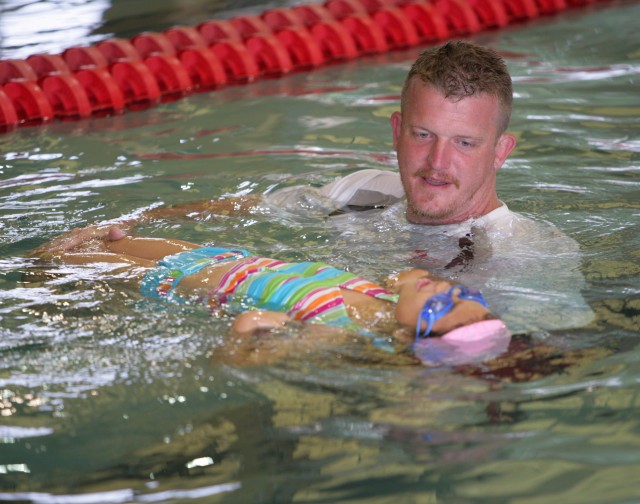
FORT SILL, Okla. -- Two Fort Sill lifeguards recently responded as they were trained to do, saving a young child from a potential drowning at Rinehart Fitness Center pool at Fort Sill, Okla.
The lifeguards' actions loomed much larger than their mere physical presence 6-foot, 4-inches for Trevor Percival and 6-foot, 7-inches for Jason Browning. These two leviathans independently assessed the situation and determined a young life was at risk. Browning, who had just returned from lunch and wasn't on duty, saw the child begin to have problems immediately after going off the diving board.
"I saw splash, splash, splash then he started to go under, and I was in the water after him," said the broad-shouldered Browning.
He added it was a good, clean save and that once he got the child out of the pool he did a secondary assessment, something lifeguards always do as first responders, confirming that the child was OK.
Browning said lifeguards are taught to respond to water emergencies with the acronym FIND that stands for:
*Figure out the problem
*Identify possible solutions
*Name the pros and cons
*Decide to act.
"This all happens instantly; if there's a kid in the water in trouble, we're after him right away," he said.
Percival, on duty at the time, soon experienced his first save situation in the three years he's lifeguarded. Though Browning reached the youth first and took control of the situation, Percival was right behind him and would have done the same. Percival said a good lifeguard is one who maintains constant vigilance scanning the water from the deep end to the shallows. Lifeguards also keep a sharp eye on the behavior of swimmers while making sure no one is underwater and in trouble. All during his shift Percival periodically completes a head count of swimmers in the water to accurately account for those he is responsible for.
In this instance, as he scanned the pool, he noticed the child, who had just surfaced from jumping in the water, wasn't swimming away from the diving area. Instead, the child bobbed up and down then the young swimmer's head went underwater.
"I noticed immediately he was having trouble and so I jumped in," said Percival. "It's something you hope is never going to happen, but I feel good that I acted how I was trained to respond."
In both Browning's and Percival's case, their value as lifeguards extend far beyond their physical reach. Percival, age 20, is working on certifications and hopes to soon train other lifeguards along with continuing to lifeguard for at least a few more years.
As for Browning, the 32-year-old, holds in-depth credentials both as a lifeguard and as the assistant manager of aquatics. In addition to his lifeguard responsibilities, Browning holds 12-15 certifications including water safety and lifeguard instructor, water safety instructor trainer, emergency oxygen and lifeguard CPR. This speaks volumes of the safety-first mind-set of the Directorate of Family and Morale, Welfare and Recreation.
"MWR is committed to providing first-rate facilities, personnel and services for its patrons and part of that commitment is staffing a corps of about 20 certified lifeguards at post pools and Lake Elmer Thomas Recreation Area," said Brian Hersey, aquatics manager. "Lifeguards complete more than 30 hours of training to ensure they are ready to keep Fort Sill swimmers safe."
Percival said parents play a key role in swimming safety. With what can be hundreds of kids using the pools or Lake Elmer Thomas Recreation Area on a weekly basis, it's impossible for lifeguards to know which children can or cannot swim well.
"They should know if their children can swim or not, and if not, have them in a life jacket at all times," he said.
He added novice youth swimmers should stay in shallow water, and parents should sign them up for the free learn to swim classes water safety instructors teach on post.
"Kids in class get used to being in the water and learn to have fun safely," said Browning. He said the American Red Cross provides guidelines of what should be taught to swimmers of various levels and gives instructors the freedom of how the classes are structured to meet these requirements.
Because lifeguards are professional rescuers, they get the same CPR training a firefighter or police officer would take. "We save or maintain life until more qualified medical people arrive and take over," said Browning who has lifeguarded for more than four years.
He holds no illusions as this being the last incident he will likely see as a lifeguard.
"That wasn't the first time I've saved someone, and it won't be the last," said Browning. "That's our responsibility to be there when people are in trouble."

Social Sharing